A new tool for finding old maps: USGS topoView
/Get your topo maps!
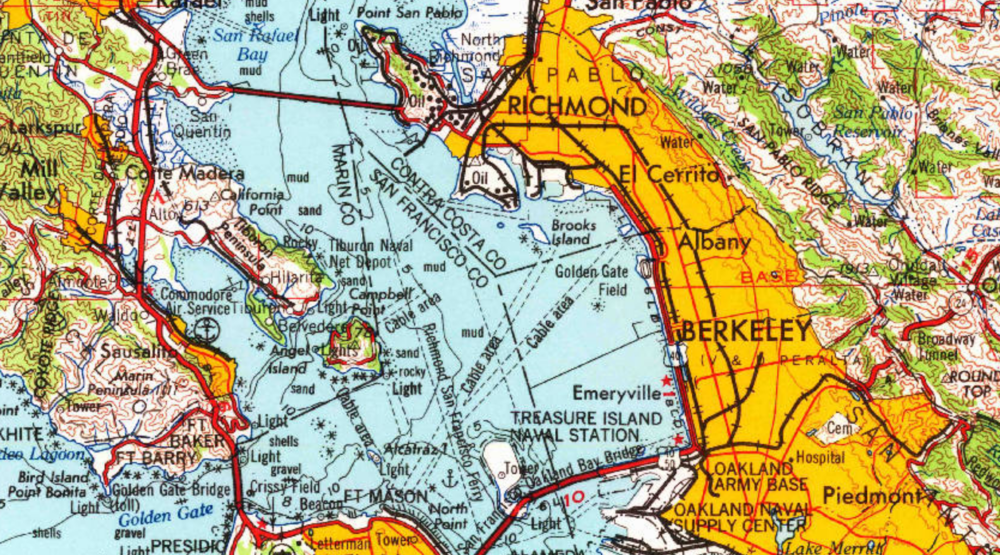
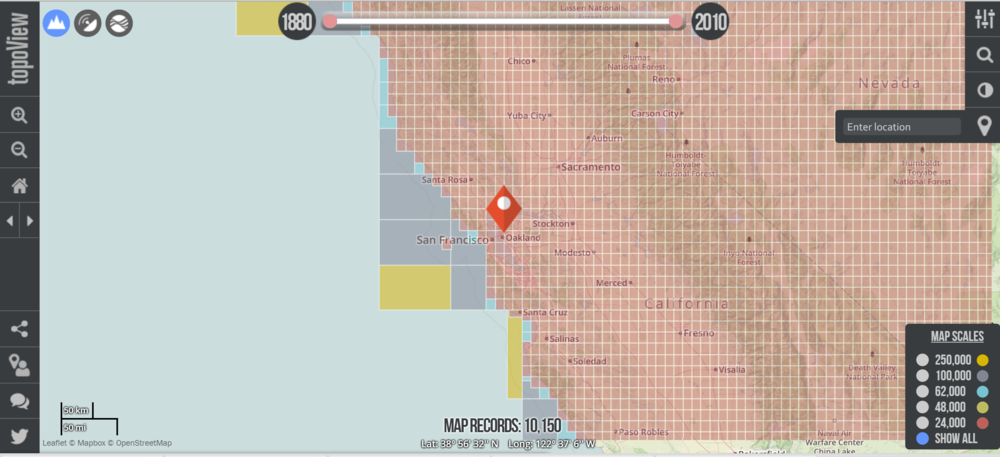
The USGS recently unvieled a new, extremely easy and enviably sleek web mapping interface to search and download nearly 178,000 topographical maps, dating from 1880 to 2010.
mapping for a changing california
Welcome to the Kellylab blog! We post fun facts and things that catch our eye. Occasionally I wax lyrically about a topic of interest.
Get your topo maps!


The USGS recently unvieled a new, extremely easy and enviably sleek web mapping interface to search and download nearly 178,000 topographical maps, dating from 1880 to 2010.
We had a great day today exploring ESRI open tools in the GIF. ESRI is interested in incorporating more open tools into the GIS workflow. According to www.esri.com/software/open, this means working with:
Open Standards: OGC, etc.
Open Data formats: supporting open data standards, geojson, etc.
Open Systems: open APIs, etc.
We had a full class of 30 participants, and two great ESRI instructors (leaders? evangelists?) John Garvois and Allan Laframboise, and we worked through a range of great online mapping (data, design, analysis, and 3D) examples in the morning, and focused on using ESRI Leaflet API in the afternoon. Here are some of the key resources out there.
Main ESRI Open Information: http://www.esri.com/software/open
Slide deck from today: http://slides.com/alaframboise/geodev-hackerlabs#/
Afternoon example using Leaflet: http://esri.github.io/esri-leaflet/
ESRI's developer toolkits: https://developers.arcgis.com/en/, including
ESRI's javascript API: https://developers.arcgis.com/javascript/beta/
Great Stuff! Thanks Allan and John
Congratulations to the NASA NEX Team! They have won the 2014 HPCwire Readers’ & Editors’ Choice Award for the Best Data-Intensive System (End User focused). See the article here: NASA Earth Exchange (NEX) Platform supports dozens of data-intensive projects in Earth sciences.
The NASA Earth Exchange (NEX) platform supports dozens of data-intensive projects in Earth sciences, bringing together supercomputers and huge volumes of NASA data, and enabling scientists to test hypotheses and execute modeling/analysis projects at a scale previously out of their reach. NEX-supported applications range from modeling El Niño, creating neighborhood-scale climate projections, assisting in crop water management, and mapping changes in forest structure across North America, to mapping individual tree crowns at continental scale as a foundation for new global science at unprecedented spatial resolution. NEX’s OpenNEX challenge ties in to White House initiatives, including Open Data, Big Data and Climate Data, which advance national goals to address climate change impacts and include competitions and challenges to foster regional innovation.
The GIF has been partnering with NASA NEX, and developing a framework to bring NEX data and analytical capabilities into HOLOS.
From this great paper I just came across (already much has changed in 2 years, but still cool):
Stefan Steiniger and Andrew J.S. Hunter, 2013. The 2012 free and open source GIS software map – A guide to facilitate research, development, and adoption. Computers, Environment, and Urban Systems. Volume 39: 136–150.
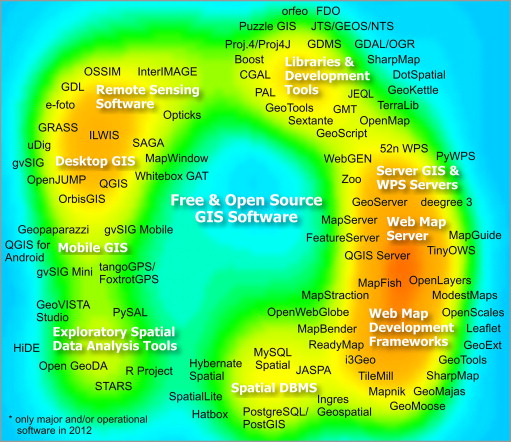
From the paper: "Over the last decade an increasing number of free and open source software projects have been founded that concentrate on developing several types of software for geographic data collection, storage, analysis and visualization. We first identify the drivers of such software projects and identify different types of geographic information software, e.g. desktop GIS, remote sensing software, server GIS etc. We then list the major projects for each software category. Afterwards we discuss the points that should be considered if free and open source software is to be selected for use in business and research, such as software functionality, license types and their restrictions, developer and user community characteristics, etc. Finally possible future developments are addressed."
One of our collaborators on the Sonoma Vegetation Mapping Project has sent work on how web mapping and high resolution imagery has helped them do their job well. These are specific comments, but might be more generally applicable to other mapping and conservation arenas.
We look forward to the continued use of this data and the effective way it is shared.
We hope that future imagery and other raster or elevation data can be served as well as this, it would benefit many engaged in science and conservation.
Thanks to Joseph Kinyon, GIS Manager, Sonoma Land Trust
Planet Mapping: The Science of 3D Maps. Find out what tools and techniques are enabling today’s modern cartographers to render 3D maps.
Location: swissnex San Francisco
730 Montgomery St., San Francisco, 94111
Our world is constantly being captured through GPS, cameras, satellites, and scanners and rendered by algorithms into navigable maps of Planet Earth. But how are 3D maps really made? How is the data collected?
Hear from some of the hottest startups in the field about the science and technology behind 3D map making—from data collection, to processing, to display—and discover how you can make your own 3D maps.
During the event, enjoy the visual stimulation of the PLACEMAKERS exhibit on view at swissnex San Francisco.
Program:
See more at: http://www.swissnexsanfrancisco.org/event/planetmapping/#sthash.G5iIInIJ.dpuf
Our world is constantly being captured through GPS, cameras, satellites, and scanners and rendered by algorithms into navigable maps of Planet Earth. But how are 3D maps really made? How is the data collected?
Hear from some of the hottest startups in the field about the science and technology behind 3D map making—from data collection, to processing, to display—and discover how you can make your own 3D maps.
During the event, enjoy the visual stimulation of the PLACEMAKERS exhibit on view at swissnex San Francisco.
6:30 pm doors open
7:00 pm intro
7:10 pm talks + Q&A
8:45 pm networking reception
Our world is constantly being captured through GPS, cameras, satellites, and scanners and rendered by algorithms into navigable maps of Planet Earth. But how are 3D maps really made? How is the data collected?
Hear from some of the hottest startups in the field about the science and technology behind 3D map making—from data collection, to processing, to display—and discover how you can make your own 3D maps.
During the event, enjoy the visual stimulation of the PLACEMAKERS exhibit on view at swissnex San Francisco.
6:30 pm doors open
7:00 pm intro
7:10 pm talks + Q&A
8:45 pm networking reception
Our world is constantly being captured through GPS, cameras, satellites, and scanners and rendered by algorithms into navigable maps of Planet Earth. But how are 3D maps really made? How is the data collected?
Hear from some of the hottest startups in the field about the science and technology behind 3D map making—from data collection, to processing, to display—and discover how you can make your own 3D maps.
During the event, enjoy the visual stimulation of the PLACEMAKERS exhibit on view at swissnex San Francisco.
6:30 pm doors open
7:00 pm intro
7:10 pm talks + Q&A
8:45 pm networking reception
Technical Tidbits From Spatial Analysis & Data Science. This nice blog highlights many technical aspects of web mapping: Leaflet, D3, R... lots of neat examples.
Just got back from an amazing workshop with the Google Earth Outreach Geo Team and 50+ geospatial educators, researchers, and lab managers!
In between stealing off on the colorful google bikes and spending time wandering the amazing Google campus, we engaged each other in discussions of integrating Google tools into higher education and learning and attended workshops introducing the plethora of Google mapping tools.
We had a warm welcome from Brian McClendon (VP of Engineering, Geo at Google, mastermind behind Google Earth, and creator of KML) who gave a great history of the program and the creation of Google Geo and gave an exciting announcement that Google; with the acquisition of Skybox is now taking to the sky with their own satellites in hand (contrary to popular belief, Google has not to this point owned any Satellites). With this acquisition, near-real live time imagery on Google platforms seems to be closer than ever before.
Rebecca Moore (Engineering Manager, Google Earth Outreach and Earth Engine) also gave a great history of the importance of Google Earth and its transformation over the years highlighting a number of exiting things to come and products not yet released to the public including
1. A new MODIS time-lapse!
From Maggi’s blog post last year on timelapse created from LANDSAT imagery we saw the amazing capabilities to see transformations over time with the click of a button. Now Google will soon release MODIS time-lapse which having a quicker repeat interval will be able to show seasonal changes .
Check out this example here showing fires across the world, and more targeted video here! Awesome!
2. Also great news for those of you tired of the coarse resolution SRTM 90 DEM, Google is currently working to produce a much higher resolution global DEM product…stay tuned!
Throughout the 3 days, I had the opportunity to attend a variety of different workshops and came away absolutely jazzed! See below for a summary of the latest and greatest from the Google Geo team with links attached if you’re interested and want more information….. Also stay tuned for some of my renderings and products from the training!
Google’s “Ecosystem” of Technologies
Mapping:
Google Maps Engine (GME): hosting data and publishing maps online, and ability to build applications and connect Google’s data with your own.
GME Pro&Lite: simple map making in the cloud, visualize, draw, import a csv, and style your maps
Maps Gallery: A new way for organizations and public institutions to publish and share their maps online through the Google maps Engine
Google Crisis Map: a map interface initially used for emergency alerts, however it’s not entirely dedicated to crisis as you can easily integrate and create your own map mashup and community awareness map here
Maps Engine API (application program interface): to access Maps Engine data, create a new applications utilizing the data, stylize and create beautiful maps
Analysis
Google Earth Engine: (EE), Google’s geospatial analysis platform. Earth Engine brings together the world's satellite imagery — trillions of scientific measurements dating back almost 40 years — and makes it available online with tools for scientists, independent researchers, and nations to mine this massive warehouse of data to detect changes, map trends and quantify differences on the Earth's surface.
Earth Engine API (application programming interface) provides the ability to create your own algorithms to process raster and vector imagery.
Timelapse builds on Earth Engine to show decades of planetary change, both man-made and natural
Data Collection
Streetview: in Google Maps and Earth provides over five millions miles of interactive 360-degree panoramas across all seven continents; it’s the closest thing to teleportation, allowing teachers and students to virtually walk almost anywhere they dream of going. Street View began on the roads, but new technologies like theTrekker backpack or an underwater rig can take you almost everywhere.
-Treks: Street view special collections (museums, up a mountain,etc..)
-Views: streetview imagery crowd-sourced from user generated 360 degree photospheres. You can now connect your photospheres to create your own street view using constellations
Mobile Data Collection using Open Data Kit allows you to collect field data, such as text, photos/videos, and GPS location from an Android device where there's no internet connection and then publish that data to the web when you're back online. You can then export your data into Google Earth Engine for mapping and Google Fusion Tables for graphing, mapping and visualization.
Visualization/ Story Telling
Tour Builder: Tour Builder is a new way to show people the places you've visited and the experiences you had along the way using Google Earth. It lets you pick the locations right on the map, add in photos, text, and video, and then share your creation. The new geo-enabled Powerpoint!
Thanks to Maggi for the opportunity to attend and the talented, enthusiastic Google Geo staff (including: Karin Tuxen-Bettman, John Bailey, David Thau, Christiaan Adams, and all the other workshop leads and those behind the scenes!) for developing such an action packed workshop!
The new Berkeley Food Institute has released its crop of funded projects from its first seed grant program. Our project Making the Road by Mapping: Informing Food System Transformation through Participatory Mapmaking was selected for seed funding. This project, led by Kathryn DeMaster includes graduate students Adam Calo (ESPM) and Sarah Van Wart (Information), Darin Jensen (Geography), Tapan Parikh (Information), Kaley Grimland-Mendoza (Agriculture and Land-Based Training Association), Amber Sciligo (Post-doc, ESPM), Christy Getz (ESPM), and Jennifer Sowerwine (Jepson Herbaria). We look forward to digging in.
Our participatory mapping research project has four primary purposes: First, we explore participatory mapping as a way to collaboratively generate new food system knowledge with scholars, practitioners, and producers. Second, through a process we term “communitysourcing,” we aim to illuminate overlooked caches of community-based knowledge and engage community members, agricultural producers and scholars in collaborative efforts to map a particular food system supply chain (small-scale organic strawberry production in the Salinas Valley). Third, we aim to integrate the interdisciplinary community-based participatory research with specific understandings of the way that certain agricultural policies either facilitate or restrict sustainable small-scale organic strawberry production in the Salinas Valley (with a particular focus on water quality and food safety policy/regulations). Fourth, we will present our findings in novel, innovative, and visually captivating ways that will: (a) Inform specific policies/regulations and; (b) Provide small-scale producers with easily accessible caches of community generated knowledge to inform their practices.
In a recent article published in the Guardian, Michelle Kilfoyle and Hayley Birch discuss the widespread use of citizen science initiatives. They recently produced a report (pdf) for the Science for Environment Policy news service, in which the authors review a number of citizen science case studies, and explore the potential benefits of citizen science for both science and society, especially given the advent of new mobile technologies that enable remote participation. They also ask interesting questions about who really benefits the most from these developments: the amateurs or the professionals?
From Greg Brown.
Helsinki, Finland is developing a new city plan for the future (http://www.hel.fi/wps/portal/Kaupunkisuunnitteluvirasto_en). Helsinki becomes possibly the first major world city to use PPGIS to inform its comprehensive city planning process. The PPGIS website was developed by Mapita (http://mapita.eu/), a software company founded by Prof. Marketta Kytta and others at Aalto University. The website launched several days ago and has already had over 5500 participants map places and preferences for the future of Helsinki.
You can visit the website here: https://helsinki.asiatkartalle.fi (There is an option to try out the website without having your map markers or survey responses included in the results…see option below the “Begin” button that says ”Try without saving answers”).
The California Geoportal, officially launched in March 2013 (see here for related launch press release), augments and in some ways replaces the original Cal-Atlas statewide GIS data download webpage with a more simplified, smooth, and more intuitive website for all GIS related data in the state. You can now search or browse for GIS data by geography and any corresponding metadata using traditional search queries as well as by using a standalone webGIS interface. The portal also provides direct download links to some Oregon and Nevada state GIS datasets. The site acts as a GIS data repository for publicly available GIS data and related documents and maps from state agencies and local and regional governments. Rather than hosting the physical data, the site instead acts as a library of direct download links to datasets that connect directly to the author’s databases. The site also links you to other state GIS applications such as the California Coastal Geoportal and webGIS viewers from various state agencies.
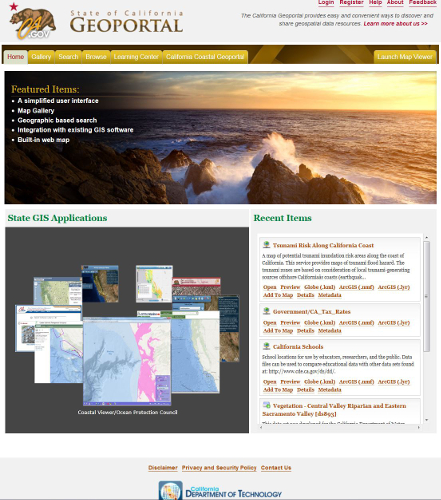
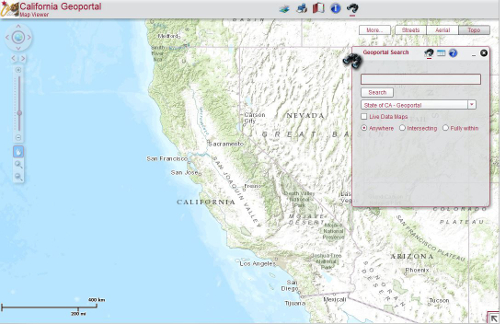
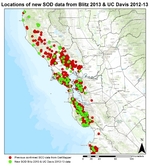 New 2013 SOD Blitz and 2012-13 UC Davis DataNew confirmed cases of Sudden Oak Death (SOD) (P. ramorum) have been added to OakMapper, a project that tracks the spread of Sudden Oak Death from data collected by citizens and organizations. All official SOD cases are collected and confirmed by the California Department of Food and Agriculture or the University of California. Community SOD cases are submitted by citizens via the OakMapper website and iPhone application. 442 new points collected between 2012-2013 have been added to OakMapper bringing the total number of confirmed SOD locations to 3246. The new data consists of laboratory confirmed cases collected by the annual SOD Blitz campaign of 2013 from the Forest Pathology and Mycology Lab run by Dr. Matteo Garbelotto and also laboratory confirmed cases collected by the UC Davis Rizzo Lab run by Dr. David Rizzo.
New 2013 SOD Blitz and 2012-13 UC Davis DataNew confirmed cases of Sudden Oak Death (SOD) (P. ramorum) have been added to OakMapper, a project that tracks the spread of Sudden Oak Death from data collected by citizens and organizations. All official SOD cases are collected and confirmed by the California Department of Food and Agriculture or the University of California. Community SOD cases are submitted by citizens via the OakMapper website and iPhone application. 442 new points collected between 2012-2013 have been added to OakMapper bringing the total number of confirmed SOD locations to 3246. The new data consists of laboratory confirmed cases collected by the annual SOD Blitz campaign of 2013 from the Forest Pathology and Mycology Lab run by Dr. Matteo Garbelotto and also laboratory confirmed cases collected by the UC Davis Rizzo Lab run by Dr. David Rizzo.
Click on the image left to view a close-up of the new confirmed SOD data (in green) from SOD Blitz and UC Davis.
Explore the new data online here.
For three days in late July 2013 Kevin Koy, Executive Director of the GIF and Maggi spent time at Google with 50+ other academics and staff to learn about Google Earth's mapping and outreach tools that leverage cloud computing. The meeting was called Google Earth for Higher Education Summit, and it was jam packed with great information and hands-on workshops. Former Kellylabber Karin Tuxen-Bettman was at the helm, with other very helpful staff (including David Thau - who gave the keynote at last year's ASPRS conference). Google Earth Outreach has been targeting non-profits and K-12 education, and are now increasingly working with higher education, hence the summit. We learned about a number of valuable tools for use in classrooms and workshops, a short summary is here.
Google Mapping Tools - the familiar and the new
Here are a couple of my first-cuts:

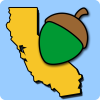 The new OakMapper logo
The new OakMapper logo
We are excited to announce the new version (2.3) of the OakMapper iPhone/iPad App, available to download now for free at the iTunes App Store [link].
In this version of the OakMapper App, the original browse and search functionalities have been retooled to improve the user interface design and user interaction. A new user can sign up for a new OakMapper account directly using the App. Users who has logged into their account can manage their profile, change their password, and submit a SOD point. The submission process has been re-engineered to achieve a better and more intuitive submission workflow. Users can also take a picture of a suspected SOD infected tree and upload it right from their iOS devices.
To explore all the new features of the OakMapper iPhone/iPad App, please install OakMapper from the iTunes App Store [link] now. Please feel free to share this App with your friends. If you like the OakMapper app, please rate the app and leave your comments in the App store. If you should have any questions, please email us at oakmapper@gmail.com.
Enjoy!
OakMapper
Shufei Lei, Web/Mobile App Developer
Maggi Kelly, Principal Investigator
www.oakmapper.org
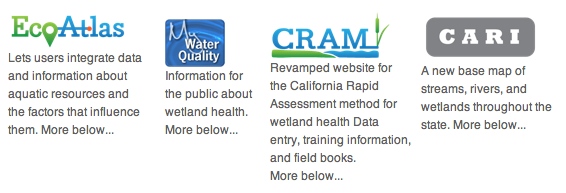 SFEI, on behalf of the Wetland Monitoring Workgroup is releasing a series of technology tools to help with aquatic resource protection and management. “These new online tools will empower Californians to access information about the value and health of their wetlands," said U.S. Environmental Protection Agency Regional Administrator Jared Blumenfeld.
SFEI, on behalf of the Wetland Monitoring Workgroup is releasing a series of technology tools to help with aquatic resource protection and management. “These new online tools will empower Californians to access information about the value and health of their wetlands," said U.S. Environmental Protection Agency Regional Administrator Jared Blumenfeld.
EcoAtlas is designed to support management decisions about wetlands. By compiling state and federal maps and data about wetlands, EcoAtlas gives site visitors access to salient information about the condition and extent of streams, wetlands, lakes, and their surrounding riparian areas. www.ecoatlas.org
The Wetlands Portal is the latest in the series of My Water Quality Portals (www.MyWaterQuality.ca.gov) designed to help the general public find answers to fundamental questions related to water quality both in their communities and across the state as a whole.
The California Rapid Assessment Method is a cost-effective and scientifically sound method for monitoring wetland condition. http://www.cramwetlands.org/
The California Aquatic Resource Inventory is a standardized statewide map of wetlands, streams, and riparian areas. http://www.sfei.org/it/gis/cari
Google recently released the Timelapse project, hosted by Time Magazine, which shows Landsat images from 1984 to today in a timelapse video animation for the entire globe. The viewer allows users to navigate to any spot on the globe via place name and visualize changes on the earth’s surface over the time period captured by Landsat. Google highlights specific areas of interest such as Dubai, Las Vegas, and the Amazon.
Click the image below for more info and to access the site:
New confirmed cases of Sudden Oak Death (SOD) (P. ramorum) have been added to OakMapper, a project that tracks the spread of Sudden Oak Death from data collected by citizens and organizations. All official SOD cases are collected and confirmed by the California Department of Food and Agriculture or the University of California. Community SOD cases are submitted by citizens via the OakMapper website and iPhone application. 613 new points collected in 2012 have been added to OakMapper bringing the total number of confirmed SOD locations to 2804. The new data consists of laboratory confirmed cases collected by the annual SOD Blitz campaign of 2012 from the Forest Pathology and Mycology Lab run by Dr. Matteo Garbelotto.
Click on the image in the upper left to view a close-up of the new confirmed SOD data (in green) from the SOD Blitz 2012.
Explore the new data online here.
Check out this neat article about how research will likely increasingly use the web, mobile apps and the citizens who love them, in gathering data and in sharing information.
Rawiya Kameir says, in the article entitled "Researchers must harness powers of web and citizen science, experts say": As the web and web-based apps become more and more sophisticated, the role played by citizen science is growing in scope and size. And as the scientific process evolves, citizen involvement - especially in scientific endeavors that require large data sets - will become a cornerstone of research.
What a great week for radio and matters geospatial+web. On Wednesday last week we finished out our GIS class with a talk about the geoweb and issues of access, bias, motivation, control, and of course privacy. I used alot of William Gibson's previous writings about Google (posted here earlier) in that lecture. Yesterday TTBOOK re-aired a great interview with Gibson, on the topic of writing, but also about the internet. I recommend it. Additionally, last week Talk of the Nation had a interesting interview with Jerry Brotton about his new book "A History of the World in Twelve Maps"; the interview touched on Google Earth and representation, why north is up, and many other fantastic questions raised through the history of cartography. Check them out!